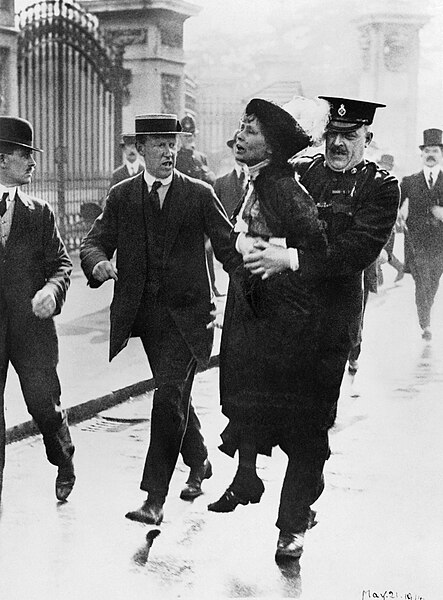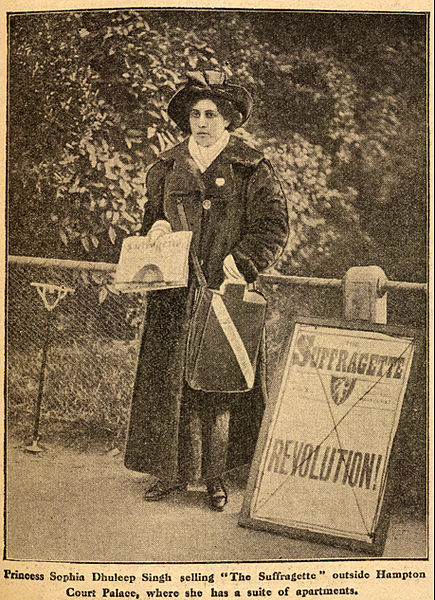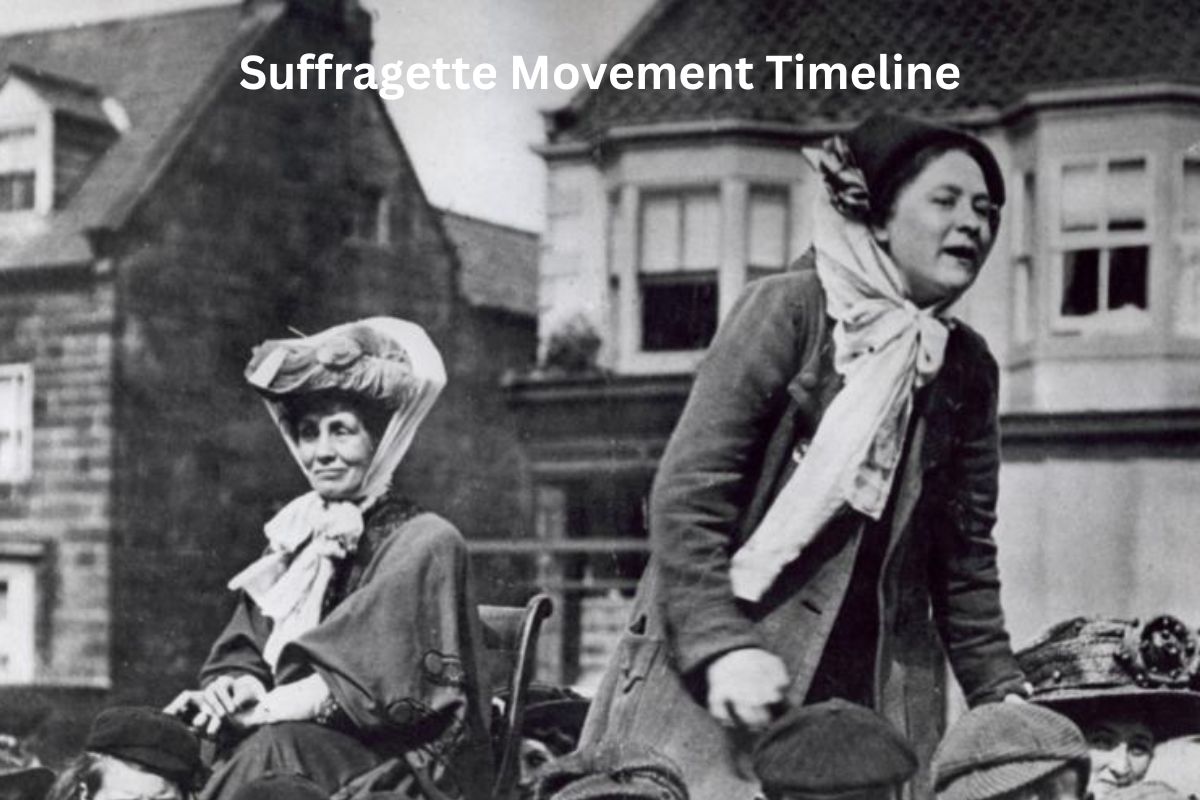The suffragette movement was a social and political campaign advocating for women’s right to vote.
Spanning from the late 19th century to the present day, it witnessed significant milestones and achievements in different countries worldwide.
Here is a brief introduction to the suffragette movement timeline:
- Late 19th Century – The movement gained momentum with the presentation of the first petition for women’s suffrage in the UK in 1866. In 1893, New Zealand became the first self-governing country to grant women the right to vote.
- Early 20th Century – The formation of the Women’s Social and Political Union (WSPU) in the UK in 1903 marked a more militant approach to suffrage activism. The suffragettes, members of the WSPU, employed tactics such as protests, civil disobedience, and hunger strikes to demand voting rights.
- Post-World War I – In 1918, the Representation of the People Act in the UK granted partial suffrage to women over 30. The 19th Amendment in the United States was ratified in 1920, granting women the right to vote.
- Late 20th Century and Beyond – Progress continued with women gaining suffrage rights in various countries. Examples include Switzerland granting federal voting rights in 1971, South Africa holding its first democratic elections in 1994, and Saudi Arabia granting suffrage rights in municipal elections in 2015.
Throughout the timeline of the suffragette movement, the efforts of activists and organizations, such as the WSPU and the National American Woman Suffrage Association, contributed to securing voting rights for women and advancing gender equality.
The movement remains an essential part of the broader struggle for women’s rights and empowerment worldwide.
| Year | Event |
|---|---|
| 1866 | First petition for women’s suffrage in the UK |
| 1893 | New Zealand grants women the right to vote |
| 1903 | Formation of the Women’s Social and Political Union (WSPU) in the UK |
| 1906 | Suffragettes begin using militant tactics in the UK |
| 1913 | Death of suffragette Emily Davison at the Epsom Derby |
| 1914-1918 | Suspension of suffrage activities during World War I |
| 1918 | Representation of the People Act passed in the UK, granting voting rights to some women over 30 |
| 1920 | Ratification of the 19th Amendment in the United States, granting women the right to vote |
| 1928 | Equal Franchise Act passed in the UK, granting women over 21 the right to vote |
| 1931 | Formation of the National League of Women Voters in the US |
| 1944 | Women in France gain suffrage rights |
| 1945 | Women in Italy and Japan obtain suffrage rights |
| 1947 | Establishment of the United Nations Commission on the Status of Women |
| 1948 | Adoption of the Universal Declaration of Human Rights by the United Nations |
| 1956 | Women in Greece gain the right to vote |
| 1962 | Women in Switzerland secure federal voting rights |
| 1965 | Signing of the Voting Rights Act in the US, removing discriminatory practices |
| 1971 | Women in Switzerland gain voting rights in all cantonal and local elections |
| 1979 | Women in Iran lose suffrage rights |
| 1994 | South Africa holds first democratic elections, granting suffrage to all races and genders |
| 2005 | Kuwait grants women the right to vote and run for office |
| 2015 | Saudi Arabia grants women the right to vote and run for office in municipal elections |
| 2020 | Sudan criminalizes female genital mutilation (FGM) |

Timeline of the Suffragette Movement
1866 – First petition for women’s suffrage presented to British Parliament
The suffragette movement began to gain momentum in the late 19th century. In this year, a petition for women’s suffrage was presented to the British Parliament by suffragist Barbara Bodichon.
The petition, signed by over 1,500 women, called for the right to vote for women on the same terms as men.
1888 – The National Union of Women’s Suffrage Societies formed
The National Union of Women’s Suffrage Societies (NUWSS) was formed in the United Kingdom. Led by Millicent Fawcett, the NUWSS adopted a peaceful and moderate approach to campaigning for women’s suffrage.
Also Read: Facts About Women’s Rights
They organized meetings, distributed literature, and conducted peaceful protests and lobbying efforts.
1893 – New Zealand grants women the right to vote
New Zealand became the first self-governing country to grant women the right to vote. The Electoral Act of 1893 extended voting rights to all women over the age of 21, regardless of their marital status or property ownership.
1897 – The “Monster Petition”
The National Union of Women’s Suffrage Societies organized a massive petition known as the “Monster Petition.”
Also Read: Facts About the Women’s Suffrage Movement
It contained signatures from over 250,000 women, demanding the right to vote. The petition was presented to the British Parliament but did not result in immediate legislative change.

1899 – NAWSA founded in the USA
The National American Woman Suffrage Association (NAWSA) was formed in the United States. Under the leadership of suffragists such as Susan B. Anthony and Elizabeth Cady Stanton, NAWSA campaigned for women’s suffrage through lobbying, public speaking, and publishing literature.
1903 – Women’s Social and Political Union (WSPU) founded in the UK
The Women’s Social and Political Union (WSPU) was founded in the United Kingdom by Emmeline Pankhurst and her daughters, Christabel and Sylvia.
The WSPU aimed to be more militant and confrontational in their tactics compared to other suffragette organizations. They believed in “deeds, not words” and began using more aggressive forms of protest to draw attention to their cause.
1914-1918 – WW1
The outbreak of World War I temporarily suspended suffrage activities as many suffragettes focused on war-related efforts.
They engaged in war work, such as nursing and factory jobs traditionally held by men, and suspended their militant tactics during this period.
1918 – Representation of the People Act passed in the UK, granting some women over 30 the right to vote
The Representation of the People Act was passed in the United Kingdom, granting some women over the age of 30 the right to vote.
This act also extended voting rights to all men over the age of 21. Although it was not full suffrage for women, it was a significant milestone.
1920 – 19th Amendment ratified in the United States, granting women the right to vote
The 19th Amendment to the United States Constitution was ratified, granting American women the right to vote. The amendment stated that the right to vote could not be denied on the basis of sex, finally securing suffrage for women after decades of activism.
1928 – Equal Franchise Act passed in the UK, giving women over 21 the right to vote
The Equal Franchise Act, also known as the Representation of the People (Equal Franchise) Act 1928, was a significant milestone in the suffragette movement in the United Kingdom.
The act was introduced and passed by the UK Parliament, receiving royal assent on July 2, 1928. It came into effect on July 2, 1928.
The act aimed to address the remaining gender inequalities in voting rights that persisted after the Representation of the People Act 1918. The 1918 act had granted the right to vote to women over the age of 30 who met certain property qualifications.
The Equal Franchise Act extended voting rights to women, granting them equal suffrage with men. It lowered the voting age for women from 30 to 21, aligning it with the voting age for men.
With the passage of the act, women in the UK aged 21 and over were finally granted the same voting rights as men, regardless of their property ownership or marital status.
1944 – Women in France gain suffrage rights
Women in France gained the right to vote. The French Provisional Government passed a law granting suffrage rights to women, acknowledging their contribution to the war effort and their demand for equal political participation.
1945 – Women in Italy and Japan obtain suffrage rights
Women in Italy and Japan obtained suffrage rights. After World War II, both countries introduced constitutional reforms that included granting women the right to vote. In Italy, women voted for the first time in the 1946 general elections, while Japanese women exercised their voting rights in 1946 local elections.
1962 – Women in Switzerland secure voting rights at the federal level
Women in Switzerland secured voting rights at the federal level. A referendum was held, resulting in a majority of Swiss male voters supporting women’s suffrage.
This granted women the right to vote in federal elections and the right to stand for federal office.
1971 – Women in Switzerland gain the right to vote in all cantonal and local elections
Women in Switzerland gained the right to vote in all cantonal and local elections. Prior to this, suffrage rights were unevenly distributed among the Swiss cantons. The final canton to grant full voting rights to women did so in 1991.
1979 – Women in Iran lost suffrage rights after the Islamic Revolution
Following the revolution, Iran implemented conservative Islamic laws that restricted women’s participation in various aspects of public life, including voting.
1994 – South Africa held its first democratic elections with universal suffrage
These elections marked the end of apartheid and granted suffrage to all South African women, ensuring equal political participation for all races and genders.
1997 – Women in Hong Kong gained the right to vote and run for office
Prior to Hong Kong’s handover from British to Chinese sovereignty, the Basic Law was enacted, granting universal suffrage rights to Hong Kong residents, including women.
2005 – Kuwait granted women the right to vote and run for office
Previously, women in Kuwait had been excluded from the electoral process. The constitutional amendment allowing women’s suffrage was a significant step toward gender equality in the country.
2011 – Saudi Arabia announced that women would be granted the right to vote and run for office in future municipal elections
The decision marked a significant development in women’s political rights in the country.
2015 – Saudi Arabia held its first municipal elections in which women could vote and run for office
This historic milestone allowed Saudi women to participate in the electoral process, marking a significant advancement for women’s political rights in the country.
2017 – The #MeToo movement gained significant momentum, highlighting widespread issues of sexual harassment and assault
The movement sparked a global conversation about gender equality and women’s rights, bringing attention to systemic issues and the need for societal change.
2018 – In Ireland, a referendum was held to repeal the Eighth Amendment of the Constitution, which effectively banned abortion
The referendum resulted in a vote to repeal, allowing for greater reproductive rights for women in Ireland.
2019 – Women’s rights activists in Argentina successfully campaigned for the legalization of abortion
The Argentine Senate passed a bill allowing for legal abortion up to 14 weeks of pregnancy, marking a significant victory for reproductive rights in the country.
2020 – Sudan criminalized female genital mutilation (FGM)
taking a major step toward protecting women’s rights and ending a harmful practice that has been prevalent in many parts of the world.
